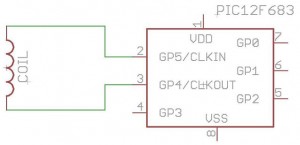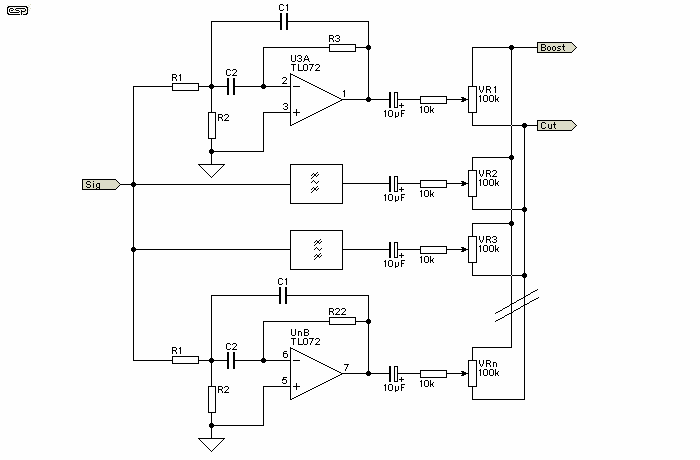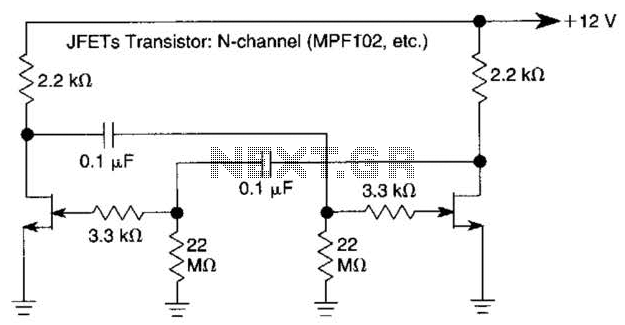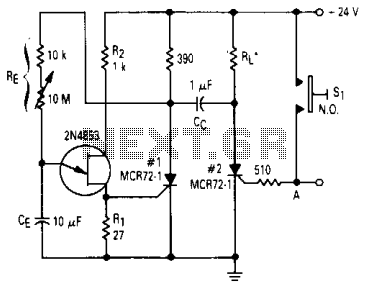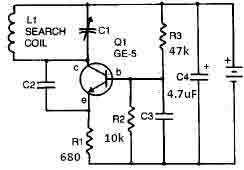
TDA1562Q Audio Amplifier Circuit
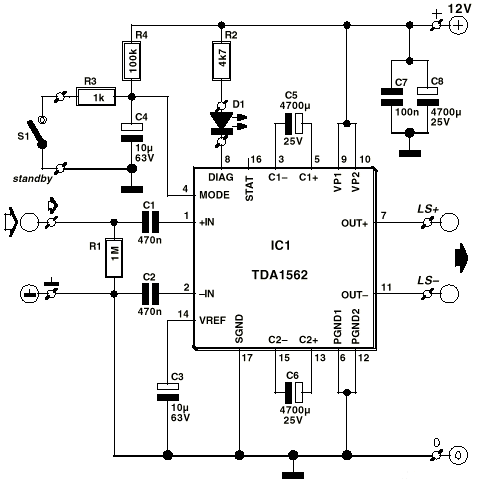
At low output power, up to 18 W, the device functions as a standard BTL amplifier. When a greater output voltage swing is necessary, the internal supply voltage is increased using external electrolytic capacitors. This momentarily elevated supply voltage allows for an output power of 70 W. The heatsink must be designed for operation with music signals. If the case temperature exceeds 120 °C, the device will revert from class-H to class-B operation. In this scenario, the high power supply voltage is disabled, and the output power is limited to 20 W. If the supply voltage falls below the minimum operating threshold, the amplifier will be muted immediately.
The described electronic circuit operates primarily as a BTL (Bridge-Tied Load) amplifier, which is capable of delivering an output power of up to 18 W under normal conditions. The design incorporates a mechanism to elevate the internal supply voltage through the use of external electrolytic capacitors, enabling the amplifier to achieve a significant output power of 70 W when required. This feature is particularly advantageous for applications involving music signals, where dynamic range and transient response are critical.
The heatsink is a crucial component in this design, as it must effectively dissipate heat generated during operation, especially at higher power levels. The thermal management system should be capable of maintaining the device's case temperature below 120 °C to ensure reliable performance and prevent thermal shutdown. If the temperature exceeds this threshold, the amplifier automatically transitions from class-H operation to class-B operation, which reduces the output power to a safer level of 20 W. This automatic switching mechanism enhances the device's longevity and reliability by protecting it from overheating.
Furthermore, the amplifier is designed with a safeguard feature that mutes the output immediately if the supply voltage drops below a critical minimum level. This protection ensures that the amplifier does not produce unwanted noise or distortion during low-voltage conditions, thereby maintaining audio quality and preventing potential damage to connected speakers. Overall, the amplifier's design reflects a balance between performance, thermal management, and protection mechanisms, making it suitable for various audio applications.At low output power, up to 18 W, the device operates as a normal BTL amplifier. When a larger output voltage swing is required, the internal supply voltage is lifted by means of the external electrolytic capacitors. Due to this momentarily higher supply voltage the obtainable output power is 70 W. The heatsink should be designed for use with music signals. If the case temperature exceeds 120 °C, the device will switch back from class-H to class-B operation. The high power supply voltage is then disabled and the output power is limited to 20 W. When the supply voltage drops below the minimum operating level, the amplifier will be muted immediately.
🔗 External reference
The described electronic circuit operates primarily as a BTL (Bridge-Tied Load) amplifier, which is capable of delivering an output power of up to 18 W under normal conditions. The design incorporates a mechanism to elevate the internal supply voltage through the use of external electrolytic capacitors, enabling the amplifier to achieve a significant output power of 70 W when required. This feature is particularly advantageous for applications involving music signals, where dynamic range and transient response are critical.
The heatsink is a crucial component in this design, as it must effectively dissipate heat generated during operation, especially at higher power levels. The thermal management system should be capable of maintaining the device's case temperature below 120 °C to ensure reliable performance and prevent thermal shutdown. If the temperature exceeds this threshold, the amplifier automatically transitions from class-H operation to class-B operation, which reduces the output power to a safer level of 20 W. This automatic switching mechanism enhances the device's longevity and reliability by protecting it from overheating.
Furthermore, the amplifier is designed with a safeguard feature that mutes the output immediately if the supply voltage drops below a critical minimum level. This protection ensures that the amplifier does not produce unwanted noise or distortion during low-voltage conditions, thereby maintaining audio quality and preventing potential damage to connected speakers. Overall, the amplifier's design reflects a balance between performance, thermal management, and protection mechanisms, making it suitable for various audio applications.At low output power, up to 18 W, the device operates as a normal BTL amplifier. When a larger output voltage swing is required, the internal supply voltage is lifted by means of the external electrolytic capacitors. Due to this momentarily higher supply voltage the obtainable output power is 70 W. The heatsink should be designed for use with music signals. If the case temperature exceeds 120 °C, the device will switch back from class-H to class-B operation. The high power supply voltage is then disabled and the output power is limited to 20 W. When the supply voltage drops below the minimum operating level, the amplifier will be muted immediately.
🔗 External reference
